Accidents and losses of B-2 Spirit bombers
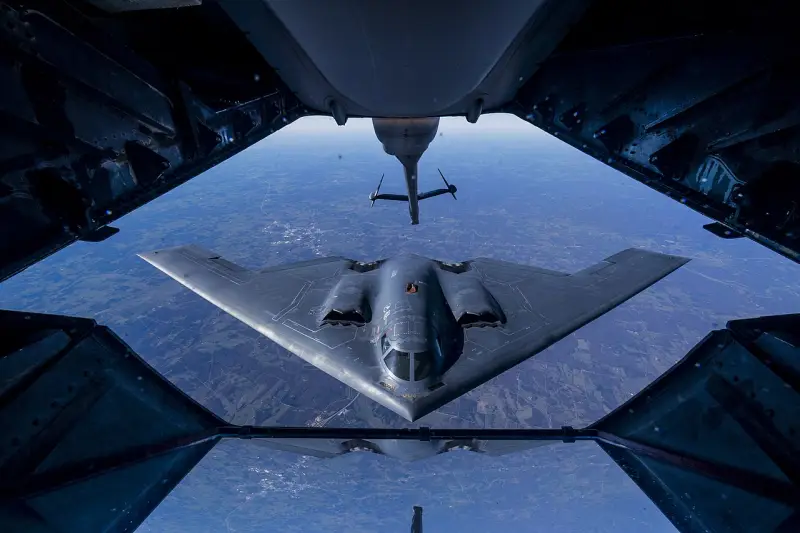
A B-2 bomber prepares to take fuel from a KC-10 tanker. Photo by US Department of Defense
The most important component of long-range aviation and the air component of the US strategic nuclear force are the B-2 Spirit stealth bombers, designed and built by Northrop Grumman. They are designed to solve the most complex tasks of a shock nature and have repeatedly demonstrated their capabilities. At the same time, the operation of the “Spirits” was not simple and easy. There have been several serious accidents in the past, and one of them even resulted in the destruction of an aircraft.
Aircraft in service
The future B-2 has been developed since 1979 as part of the Advanced Technology Bomber program. In 1981, the competitive part of the program ended, the winner of which was Northrop. Her preliminary draft was further developed; it was given the index B-2 and the name Spirit. The design was completed in the second half of the eighties, after which construction of the first prototype aircraft began.
In November 1988, the aircraft was first shown to the public, and in July 1989, its flight tests began. Later, five more bombers were taken out for testing. The fine-tuning and modification of the most complex aircraft lasted for several years and was completed only in the mid-nineties. In 1997, the B-2 officially entered service, and the first squadron soon reached initial operational capability.
Since the early eighties, the desired number of aircraft and possible series volumes have been discussed. The expected cost of the serial "Spirit" was constantly growing, which led to a reduction in production plans. As a result, they decided to limit themselves to only 21 aircraft. The Air Force's combat strength included all prototypes, as well as 15 new aircraft. The average cost of one production B-2, taking into account development costs, exceeded $2,1 billion (approx. $3,9 billion at current prices).
Combat use of the newest bombers began in 1999 during the NATO invasion of Yugoslavia. B-2s flew combat missions from Whiteman Airfield in the state. Missouri and with several refuelings reached Yugoslav airspace. Using JDAM guided bombs and other ammunition, they suppressed air defenses and hit other targets.
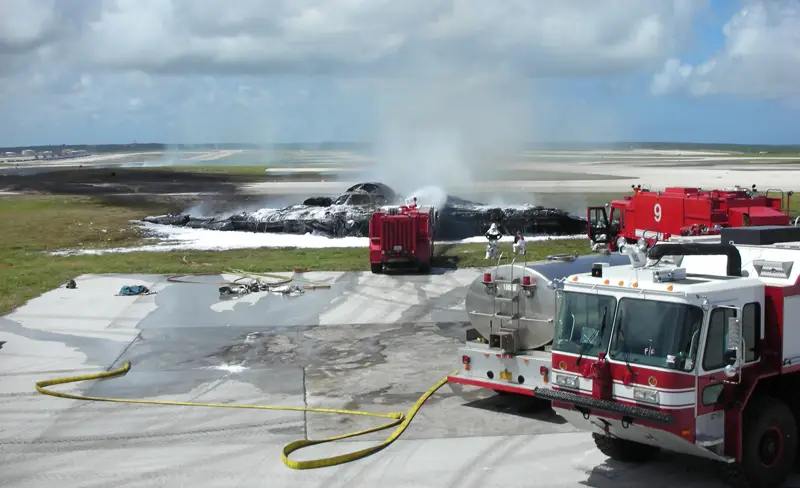
Consequences of a fire at Andersen Airfield on February 23, 2008. Photo by the US Federal Aviation Administration
At the beginning of the 2s, “Spirits” worked in a similar way on targets in Afghanistan and Iraq. At the same time, additional forward airfields outside the United States were activated during Iraqi Freedom. The latest episodes of the use of B-2011s relate to the NATO operation in Libya in XNUMX.
Due to the specific design and technologies used, the B-2 Spirit is not easy or cheap to operate. Each flight requires complex preparation and maintenance after the aircraft returns to the airfield. In addition, various technical problems regularly arise that require attention. Fortunately for the Pentagon, most of these problems are resolved routinely and do not lead to negative consequences other than unnecessary labor costs.
Fire on takeoff
The first major and notable flight incident involving a B-2 bomber occurred on February 23, 2008. The aircraft, serial number AV-12 and personal name Spirit of Kansas, from the 393rd Bomb Squadron, built in 1995, was making a scheduled takeoff from Andersen Air Force Base on O. Guam.
The take-off run proceeded normally, but a few seconds after take-off the plane banked to the left. Then he hit the runway with his wing, fell, received serious damage and caught fire. The pilots managed to eject before the fall and remained alive, although they were injured. Despite all the efforts of firefighters, the bomber burned out and could not be restored.
A special Pentagon commission conducted an investigation and identified the causes of the accident. It turned out that during preparation for the flight, the technical staff did not turn on the heating of the air pressure receiver, and condensation remained in the latter. Water interfered with the normal operation of the altitude and speed sensors, causing the crew and control system to receive incorrect data.
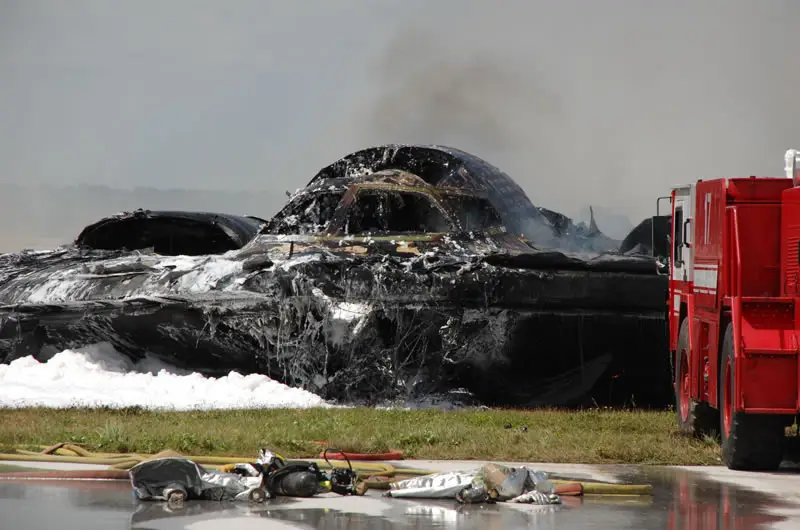
Remains of a burned-out B-2, 2008. Photo by the US Federal Aviation Administration.
As data from the flight recorders showed, the altitude error was approx. 41 m. In addition, the sensor on the PVD issued a signal that the liftoff speed was reached at 163 mph (262 km/h) when the actual speed was 154 mph (248 km/h). The pilots and avionics did not make any mistakes and performed the liftoff in the correct manner. However, at insufficient speed, the bomber could not stay in the air and gain altitude, which led to a stall and hitting the ground.
As a result of the investigation, additional instructions emerged regarding the need to carefully follow all instructions for preparing for departure. As far as is known, any modifications to the aircraft were not required and were not carried out. Due to the correct organization of work, it was possible to exclude similar incidents in the future.
The Spirit of Kansas remains the only loss of any B-2 built, but the accident was highly sensitive to the USAF. First of all, due to the high cost of technology. The fire destroyed an aircraft worth more than $2 billion, making it the most expensive crash in history. stories world aviation. In addition, there were only 21 bombers in service, and the decommissioning of even one had a negative impact on the entire fleet. Finally, due to the investigation, B-2 flights were grounded for 53 days, which hit the capabilities of the Air Force and Strategic Nuclear Forces.
Incidents without losses
Exactly two years later, in February 2010, an accident occurred again at the Andersen base. On the AV-11 Spirit of Washington, one of the engines caught fire during startup. The fire quickly spread through the tail section of the airframe and damaged it, as well as destroying part of the internal equipment. Fire crews managed to extinguish the bomber and prevented its destruction.
The plane was subject to restoration, but the repair turned out to be extremely difficult and lengthy. For a year and a half, specialists from Northrop-Grumman and the Air Force restored its structure in one of the hangars at Andersen Air Force Base. The aircraft was then flown to the continental United States to continue repairs. The Spirit of Washington returned to service only in December 2013 and set a record for repair time.
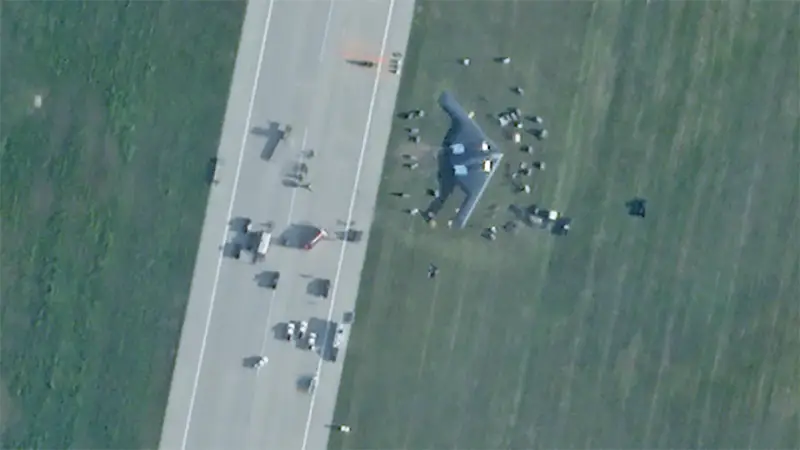
B-2 outside the Whiteman AFB runway, September 2021. Photo by Planet Labs
The investigation established the reasons for the incident, but they were not publicly published. At the same time, it was recommended to improve the fire-fighting equipment of air bases in case of further similar incidents.
The next notable accident occurred on September 14, 2021 at Whiteman AFB. During landing, the AV-14 Spirit of Georgia bomber skidded off the runway and landed on its wing, sustaining some damage. The Pentagon did not specify the circumstances of the incident, although it noted the absence of casualties and destruction.
The American press reported that the cause of the accident was a hydraulic failure, which caused one of the main landing gear to collapse. The plane lost stability during the run and was carried off the runway. Repairs to the bomber were estimated at $10 million.
The last known incident with a B-2 occurred on December 10, 2022. One of the bombers (number and name unknown) made an emergency or emergency landing at Whiteman Airfield. A fire occurred, which was quickly extinguished. There were no official reports of this incident, although it became known that all B-2 flights had been grounded.
In 2023, the Air Force command acknowledged the fact of a certain accident, but did not name the specific aircraft or indicate the causes and consequences. Apparently the incident was not serious. The plane was soon returned to service, and flights of all available equipment were also allowed fleet.
Strategic reliability
Northrop Grumman B-2 Spirit long-range bombers have been flying, including testing, since 1989, and full operation in the Air Force began in 1997. Over the past decades, a lot of operating experience has been accumulated, both positive and negative. In addition, we collected large statistics on flights and combat use, as well as flight accidents and accidents.
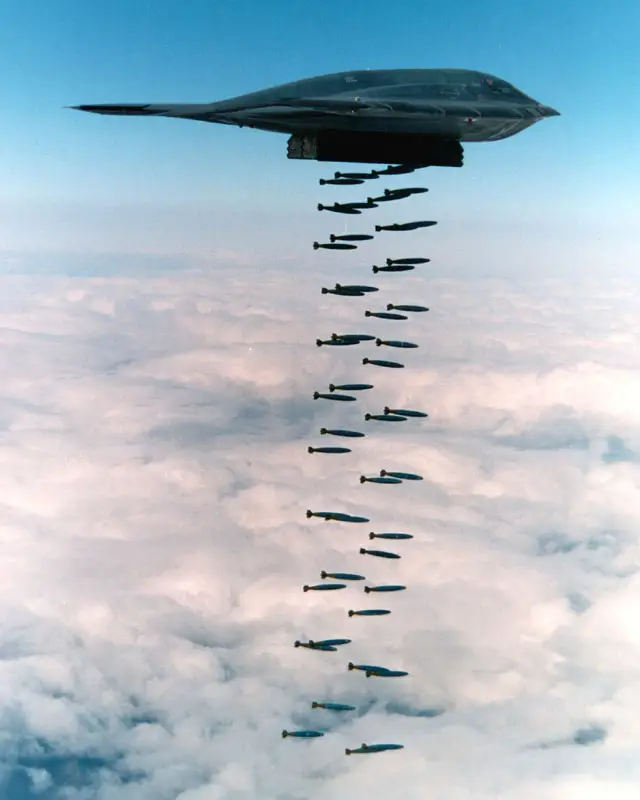
Training bombing, as part of tests in 1994. Unguided Mk 82 bombs are used. Photo of the US Department of Defense
All data of this kind is, for obvious reasons, not available to the public. However, outwardly, the operation of B-2 bombers looks quite decent. During the entire period, including flight tests, only one aircraft was lost, and for technical reasons. Three more aircraft were damaged but were able to return to service. At the same time, the Spirit fleet had no combat losses.
However, not everything is so simple. Attention should be paid to the dates of known major accidents. The first and only loss of the B-2 occurred 11 years after they began service. The next incident occurred two years later. Then there was a quiet decade, after which two more accidents occurred with an interval of just over a year.
It may seem that in the past accidents were extremely rare, but in recent years they have become almost a regular occurrence. There is little basis for such conclusions yet, but you won’t be surprised at the next accidents and losses, if they happen. The newest B-2 Spirit is already 25-26 years old, and their age should affect their operational features.
However, in general, there is reason to talk about the reliability of the design and equipment of the bombers, as well as a well-established system of flight preparation and after-flight maintenance. This is not surprising and even logical. The fact is that B-2 aircraft occupy a special place in the system of strategic nuclear and non-nuclear deterrence, and the inability to fully operate and use them can have the worst consequences for national security. In the context of the deteriorating international situation observed in recent years, the readiness of strategic bombers is of particular importance.
In addition, there are other obvious factors that stimulate a responsible attitude towards technology. Thus, B-2s are distinguished by record cost and complexity. Any operating and maintenance costs are justified if they allow you to keep an aircraft worth several billions in service.
With all this, the Pentagon will have to make every possible effort to continue operating existing bombers, because There is no replacement for them yet. The promising B-21 aircraft has only recently entered testing, and a possible replacement for the current B-2 remains a matter of the distant future. Therefore, the Spirits will remain in service, and they will still have the opportunity to prove their reliability.
Information